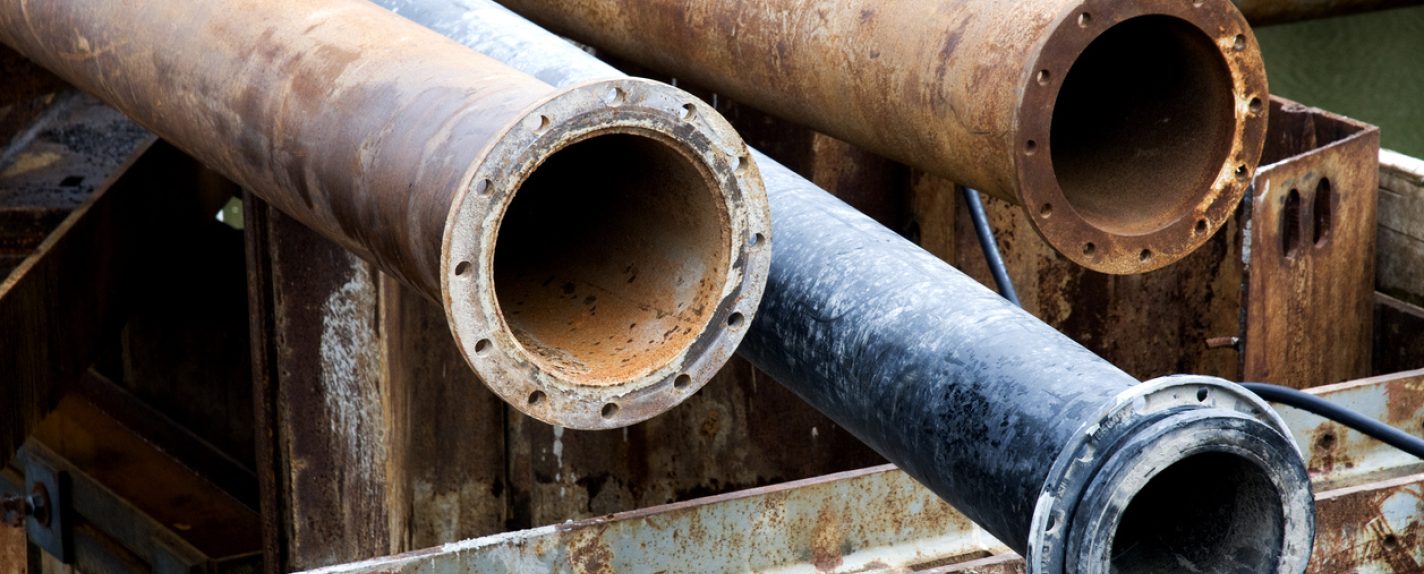Water Utilities to Replace Lead Pipes Nationwide Under Draft Rule

Newsletter Articles
EPA this month proposed new requirements on water utilities that would require thousands of water utilities to locate, investigate, and replace all lead service lines in the United States within 10 years— only adding to steep and mounting costs from their other obligations, such as PFAS cleanup. The proposed Lead and Copper Rule Improvements would also lower the threshold for lead in drinking water. EPA estimates a nationwide cost to public water systems of $2.1 to $3.6 billion per year to meet the new rule’s proposed requirements.[1] These new costs raise serious questions about where water utilities will obtain the funds and resources needed to comply, when those same utilities are already facing a staggering $5.2 billion annualized cost to treat PFAS in drinking water supplies.[2]
Only lead service lines “under control of” the water system, defined as being adequately accessible legally and physically, must be replaced under Lead and Copper Rule Improvements.[3] The proposed rule leaves uncertain how water utilities will be required to address lead pipes not under their control—potentially thousands of miles of pipe under homes where customers own the service line between the water meter and the tap (a question of state or local law).[4] Where part of a lead service line is under a consumer’s control, the proposed rule provides that a water system must make “reasonable efforts” to obtain the consumer’s permission to replace the full line.[5] EPA is still deliberating on what will amount to “reasonable efforts” in these circumstances, but it has suggested that the final rule may require at minimum multiple attempts at obtaining customer consent through multiple communication methods.[6] Notably, the Association of Metropolitan Water Agencies has identified “lack of access to the private side of the service line” as a barrier to full lead service line replacement.[7]
Written comments on the proposed rule are due by February 2, 2024.[8] EPA is also hosting a virtual public hearing on January 16, 2024 to hear comments on the proposed rule.[9]
Background
EPA’s first major effort to address lead in drinking water came in 1991 when it enacted the Lead and Copper Rule, under which an exceedance at the tap of 15 µg/L of lead triggered corrosion control treatment or, if that failed, replacement of lead service lines.[10]
On January 5, 2021, EPA promulgated a substantial update of the 1991 rule, termed the Lead and Copper Rule Revisions.[11] The revisions came following an EPA finding that only 1% of lead service lines had been replaced under the 1991 rule, with corrosion control treatment being the predominant remedy.[12] The 2021 revised rule (the controlling rule at present) creates a lower lead action level; requires water utilities to investigate and maintain records on lead service lines; expands corrosion control treatment requirements; requires water systems with high lead levels to replace a portion of their lead service lines every year; updates sampling criteria; imposes new consumer-notification requirements in the event of exceedances of the lead action level; and requires water utilities to test for lead in drinking water at schools and childcare facilities.[13]
In December 2021, the Biden Administration issued a Lead Pipe and Paint Action Plan that previewed future EPA regulatory action to replace lead pipes nationwide.[14] On November 30, 2023, EPA announced further revisions to the 2021 rule, dubbed the Lead and Copper Rule Improvements, or “LCRI.”
Lead Pipe Replacement
The centerpiece of the proposed rule is requiring water utilities to replace lead service lines nationwide. The rule would also require the utilities to replace galvanized service lines downstream of a lead pipe or that were downstream of a lead pipe but have since been relocated (such pipes are treated the same as lead service lines under the proposed rule due to their lead-adsorption qualities). Under the proposed rule, each water utility must develop and annually update a publicly accessible inventory on service lines and their composition.[15] Water utilities will be required to investigate and determine the materials used in service lines of unknown composition.[16] Water systems would also be required to assess the accuracy of earlier investigations of service lines that have previously been designated as non-lead—by submitting inventories to state regulators and conducting new inspections when customers express concern that their service lines were incorrectly categorized.[17]
A water system with at least one lead service line in its inventory must develop and make publicly accessible a lead service line replacement plan.[18] Ultimately, a water system must replace any lead service lines within 10 years (even if no lead action level is exceeded), or as soon as a state determines is feasible.[19] This replacement must occur at an annual rate of 10% per year.[20]
One of the thorniest issues will be determining how to address lead service lines that are not fully under the water utility’s control. “EPA expects that, in cases where customer consent is required by State or local laws to complete full service line replacement, some customers may not consent to replace the full service line.”[21] In these situations, the proposed rule states that water utilities must make a “reasonable effort to obtain property owner consent,” defined as at least four attempts to engage with the customer using at least two different communication methods.[22] EPA has solicited comment specifically on whether “reasonable efforts” should be defined more strictly by increasing the required number of attempts to reach the customer for consent, suggesting that the right number could be seven attempts or more.[23] The proposed rule also acknowledges the situation in which the water utility may have a legal right of access to replace the full service line, but the customer nevertheless resists the replacement for “reasons including mistrust of the water system or government, not believing the replacement is important, or to avoid the disruption to landscaping that may result from a replacement”[24]—EPA is soliciting comment on whether such resistance should excuse the water utility from replacing the associated lead service line over concerns for worker safety.
The Association of Metropolitan Water Agencies lauded EPA’s goal of identifying and replacing all lead services lines across the country, while highlighting certain barriers to that goal, including “increasing costs, supply chain disruptions, workforce shortages, incomplete or missing building records, and lack of access to the private side of the service line.”[25]
Compliance Costs
The cost of compliance with the proposed rule will be between $21 billion and $36 billion over a 10-year period.[26] Although the Bipartisan Infrastructure Law dedicated $15 billion specifically for lead service line replacement projects via low-interest loans,[27] many water utilities will be forced to locate financing options to make up the shortfall. Possible avenues of funding may be grant programs established by the Water Infrastructure Improvements for the Nation Act, low-cost financing from the Water Infrastructure Finance and Innovation Act, certain programs administered by HUD and USDA, and funding under state law.[28]
These costs come on top of massive and mounting costs borne by water providers to treat drinking water supplies across the country for PFAS. The USGS estimates that nearly half of tap water across the country is contaminated with one or more PFAS,[29] and treating PFAS has been estimated to cost $5.2 billion annually.[30] As we have previously written, water utilities face substantial uncertainty about where funding for PFAS will come from, and many have turned to litigation against PFAS and AFFF manufacturers,[31] and opportunities under the Bipartisan Infrastructure Act and state programs.[32]
Action and Trigger Level Updates
Under the current rule, water providers must conduct additional planning, monitoring and treatment if lead sampling levels are above 10 µg/L but at or below 15 µg/L.[33] The proposed rule would reduce the Action Level for lead from 15 µg/L to 10 µg/L and would remove the lead trigger level altogether.[34] An action level exceedance requires the water utility to install or re-optimize corrosion control treatment, provide public education, and give public notice within 24 hours of the detection.[35] Systems that can replace all lead service lines or galvanized services lines requiring replacement within five years may qualify for deferring the requirement to install re-optimization of corrosion control treatment.[36]
Because the proposed rule would require all lead service lines to be replaced, it would remove the lead service line replacement requirement associated with action level exceedances.[37]
Tap Sampling Protocol
Under the proposed rule, EPA plans to make several changes to the sampling protocol to ensure that sites with the highest lead levels are identified. The key proposed changes include: (1) updating sample collection locations and methods, (2) updating sampling frequency, and (3) updating the 90th Percentile Lead Calculation currently set out in EPA’s 2021 Lead and Copper Rule Revisions.[38]
First, EPA plans to require systems to take both first- and fifth-liter paired samples at the tap and to use the higher of the two values to calculate the 90th percentile lead level. Michigan has already implemented this process, and in that state it has led to more systems finding exceedances of the action level than either the first- or fifth-liter sample alone because of variability in systems.[39]
The updated sampling methods also include several corrections to definitions in the 2021 Lead and Copper Rule Revisions. Certain sites with a non-lead service line but with lead plumbing on the premises would be recategorized as among the highest-risk sites in the lead sampling priority list, which is structured by “tiers”—Tier 1, lead-impacted single-family residences, and Tier 2, lead-impacted multi-family residences, are the highest priority sites for sampling.[40] These sites were inadvertently removed from Tiers 1 and 2 in the 2021 Lead and Copper Rule Revision.[41] In addition, EPA plans to correct and expand the definition of a Tier 3 site such that Tier 3 includes: (1) sites with galvanized service lines or galvanized premise plumbing if they were ever downstream of a lead service line or lead connector, and (2) other sites currently served by a lead connector.[42]
Second, EPA would maintain the six-month monitoring frequency as the standard.[43] With the elimination of the trigger level and the reduction of the action level, EPA proposes that small and medium systems that are required to monitor only annually could qualify for triennial monitoring if they do not exceed the lead and copper action levels for three consecutive years (instead of meeting the trigger level for three consecutive years).[44]
All systems may qualify for reduced monitoring if certain requirements are met. First, EPA plans to maintain the pathway for systems to qualify for annual monitoring if they do not exceed the 10 µg/L action level for two consecutive six-month monitoring periods.[45] Additionally, all systems that measure 90th percentile levels[46] at or below the practical quantitation limits (5 µg/L for lead and 650 µg/L copper) for two consecutive six-month monitoring periods may qualify for triennial monitoring.[47]
Finally, EPA is proposing to update the types of non-compliance samples that may be included in the 90th percentile calculation by excluding samples following full or partial service line replacement, as the replacement process can result in short-term increases in lead from line disturbance.[48]
Notice and Customer Outreach Protocol
EPA is also modestly strengthening the public education framework for customers served by lead service lines, galvanized lines requiring replacement, or unknown service lines.[49] The primary changes under the proposed rule are that systems would be required to provide public outreach for: (1) failure to meet the service line replacement rate, (2) service line disturbance, including for activities related to inventorying lead service lines, and (3) tap sample results, including that EPA is proposing to decrease the time for notification of results to three days.[50] The proposed rule would also eliminate notification requirements tied to the goal-based replacement program.[51]
EPA has previously issued a “Public Notification Handbook” to assist water utilities with these sorts of public outreach efforts.[52]
Conclusion
The proposed Lead and Copper Rule Improvements are ambitious, but they add significant costs for water utilities that may already be struggling to obtain funding for other capital projects like treating PFAS in drinking water supplies. In particular, how the lead pipe replacement requirement ultimately accounts for lead service lines not under the control of the water utility charged with replacing them deserves continuing attention.
For more information on the proposed rule, or to submit a comment, please contact Marten Law’s water-quality attorneys, including Jeff Kray, Jessica Ferrell, Bryce Brown, or Victor Xu.
[1] National Primary Drinking Water Regulations for Lead and Copper: Improvements at 346, 88 Fed. Reg. 84878, 84981 (Dec. 6, 2023) (to be codified at 40 C.F.R. Parts 141 and 142).
[2] Black & Veatch, WITAF 56 Technical Memorandum PFAS National Cost Model Report at app. A-1, prepared for AWMA (March 7, 2023).
[3] 88 Fed. Reg. 84920.
[4] See, e.g., Portland.gov, About Portland’s water system, https://www.portland.gov/water... (last accessed Dec. 4, 2023).
[5] 88 Fed. Reg. 84923.
[6] 88 Fed. Reg. 84923.
[7] Association of Metropolitan Water Agencies, AMWA reacts to proposed Lead and Copper Rule Improvements (Nov. 30, 2023), https://www.amwa.net/press-rel....
[8] 88 Fed. Reg. 84878.
[9] EPA, Proposed Lead and Copper Rule Improvements (Dec. 1, 2023), https://www.epa.gov/ground-wat....
[10] 40 C.F.R. Part 141, Subpart I.
[11] National Primary Drinking Water Regulations: Lead and Copper Rule Revisions, 86 Fed. Reg. 4198 (Jan. 5, 2021) (codified at 40 C.F.R. Parts 141 and 142).
[12] EPA, The New Lead and Copper Rule, EPA (Dec. 21, 2020), https://www.epa.gov/sites/defa....
[13] National Primary Drinking Water Regulations: Lead and Copper Rule Revisions, 86 Fed. Reg. 4198, 4200–01 (Jan. 5, 2021).
[14] White House, FACT SHEET: The Biden-Harris Lead Pipe and Paint Action Plan (Dec. 16, 2021), https://www.whitehouse.gov/bri....
[15] 88 Fed. Reg. 84884.
[16] 88 Fed. Reg. 84933–34.
[17] 88 Fed. Reg. 84935.
[18] 88 Fed. Reg. 84920.
[19] 88 Fed. Reg. 84920.
[20] 88 Fed. Reg. 85006.
[21] 88 Fed. Reg. 84922.
[22] 88 Fed. Reg. 84923.
[23] 88 Fed. Reg. 84923.
[24] 88 Fed. Reg. 84923.
[25] Association of Metropolitan Water Agencies, AMWA reacts to proposed Lead and Copper Rule Improvements (Nov. 30, 2023), https://www.amwa.net/press-rel....
[26] 88 Fed. Reg. 84981.
[27] 88 Fed. Reg. 84904.
[28] 88 Fed. Reg. 84903–05.
[29] https://www.usgs.gov/news/nati...
[30] Black & Veatch, WITAF 56 Technical Memorandum PFAS National Cost Model Report at app. A-1, prepared for AWMA (March 7, 2023).
[31] J. Kray, J. Ferrell & J. Ross, PFAS Settlements: How Much is Enough?, Marten Law (June 28, 2023), https://www.martenlaw.com/news....
[32] J. Kray & J. Ferrell, Substantial PFAS Funding in Infrastructure Act Flows Towards Protecting Water and Wastewater Systems, Marten Law (Dec. 1, 2021), https://www.martenlaw.com/news....
[33] 40 C.F.R. § 181.40(c).
[34] 88 Fed. Reg. 84902.
[35] 88 Fed. Reg. 84887.
[36] 88 Fed. Reg. 84880.
[37] 88 Fed. Reg. 84888.
[38] 88 Fed. Reg. 84888–89.
[39] 88 Fed. Reg. 84930.
[40] 88 Fed. Reg. 84930. Note that “Tiers” correspond to sites’ sampling priority.
[41] 88 Fed. Reg. 84930.
[42] 88 Fed. Reg. 84930.
[43] 88 Fed. Reg. 84930–31.
[44] 88 Fed. Reg. 84930–31.
[45] 88 Fed. Reg. 84930–31.
[46] The 90th percentile level is used for action level and monitoring requirements for tap water under LCRI, as under previous iterations. For example, in a set of 10 samples, the 9th highest sample would be compared to the action level.
[47] 88 Fed. Reg. 84930–31.
[48] 88 Fed. Reg. 84932.
[49] 88 Fed. Reg. 84946–49.
[50] 88 Fed. Reg. 84946–49.
[51] 88 Fed. Reg. 84946–49.
[52] EPA, Public Notification Rule Compliance Help for Water System Owners and Operators (last updated May 17, 2023), https://www.epa.gov/dwreginfo/....
Newsletter Articles
Authors
Authors
Stay Informed
Sign up for our law and policy newsletter to receive email alerts and in-depth articles on recent developments and cutting-edge debates within our core practice areas.

